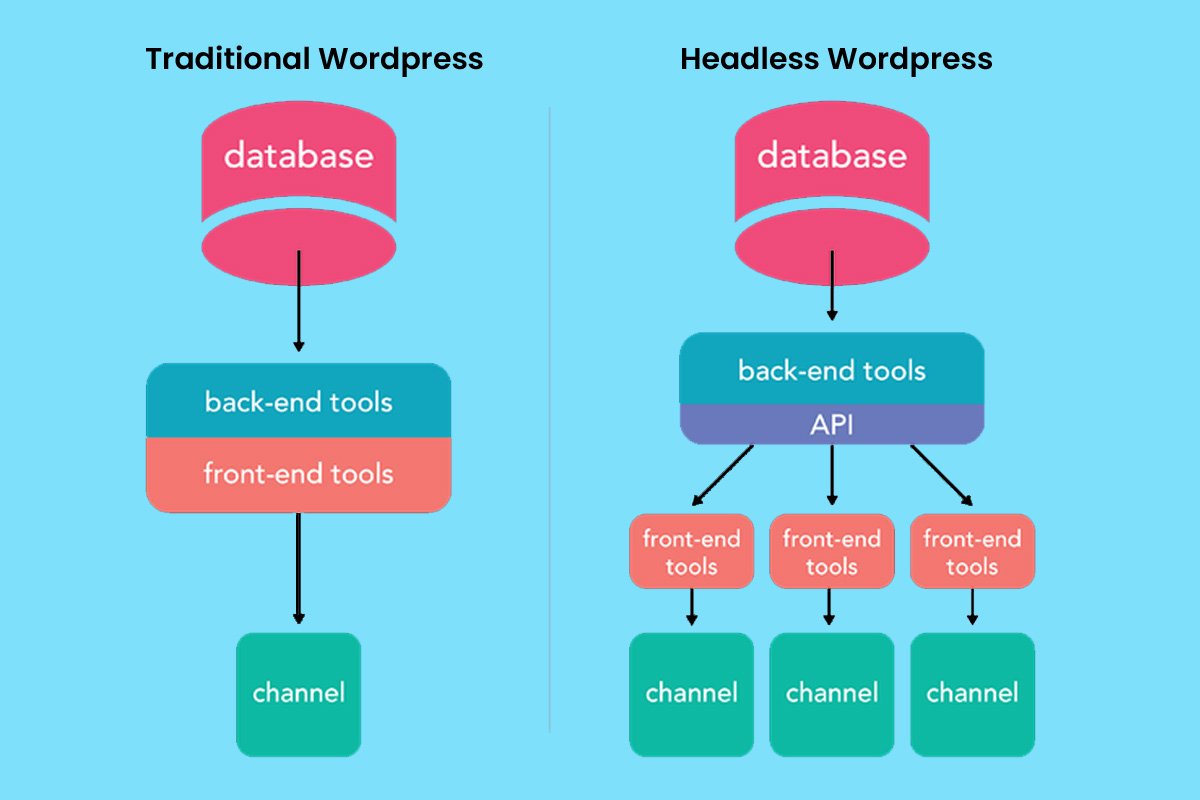In the ever-evolving landscape of web development, flexibility and performance are paramount. Headless WordPress has emerged as a powerful approach that empowers developers to achieve just that. In this article we will understand what Headless WordPress is, the benefits of Headless WordPress, how to setup one, and finally who it is for. Let’s get started!
The Concept of Decoupling
At its core, Headless WordPress revolves around the concept of “decoupling.” Traditionally, WordPress tightly integrates its content management and presentation layers. This means that your content is inherently tied to the themes you use. However, a headless architecture changes this paradigm.
In a Headless WordPress setup:
- WordPress as a Content Engine: WordPress acts solely as a content repository. You use its familiar interface to create, edit, and manage your content.
- API-Driven Content Delivery: The WordPress REST API serves as the bridge, enabling other applications to access your content in a structured format (JSON).
- Front-End Freedom: Developers gain the freedom to choose any front-end technology they prefer. Whether it’s React, Vue.js, Angular, or even a native mobile application, the possibilities are endless.
Benefits of Headless WordPress
- Enhanced Flexibility: Headless WordPress allows for greater flexibility in front-end development. Developers can use modern JavaScript frameworks and tools to build dynamic and engaging user experiences.
- Improved Performance: By separating the front-end, you can optimize it for speed and performance. Front-end frameworks often provide faster rendering and improved user experience.
- Omnichannel Delivery: Headless WordPress enables you to deliver your content to various platforms and devices, including websites, mobile apps, and IoT devices.
- Increased Security: Decoupling the front-end can enhance security by reducing the attack surface.
Considerations
While Headless WordPress offers numerous advantages, it’s essential to consider the following:
- Development Complexity: Implementing a headless setup requires more advanced development skills.
- Plugin Compatibility: Some WordPress plugins may not be fully compatible with a headless architecture.
- “What You See Is What You Get” (WYSIWYG) Limitations: depending on your front end setup, traditional wordpress previewing may be altered.
Who is it for?
Headless WordPress is particularly well-suited for:
- Developers seeking greater control and flexibility.
- Businesses requiring omnichannel content delivery.
- Projects demanding high performance and scalability.
Setting Up Headless WordPress
Setting up a Headless WordPress environment involves a few key steps:
1. WordPress Configuration:
- WordPress Installation:
- Begin with a standard WordPress installation. Ensure it’s up-to-date.
- Enabling the WordPress REST API:
- The WordPress REST API is essential for delivering content. It’s built into WordPress core, so it’s generally enabled by default. However, verifying that permalinks are set to something other than “plain” is important. This is because the REST API relies on proper permalink structures.
- Go to Settings > Permalinks and select “Post name” or another suitable option.
- Plugins (Optional but Recommended):
- WPGraphQL:
- For more efficient data fetching, consider installing the WPGraphQL plugin. This plugin allows you to query your WordPress data using GraphQL, which can be more powerful than the REST API for complex data requests.
- ACF to REST API:
- If you are using Advanced Custom Fields, the ACF to REST API plugin will allow those custom fields to be available within the API.
- WPGraphQL:
2. Front-End Setup:
- Choose a Front-End Technology:
- Select the front-end framework or technology you want to use. Popular choices include:
- React
- Vue.js
- Angular
- Next.js
- Gatsby.js
- Select the front-end framework or technology you want to use. Popular choices include:
- Setting up the Front-End Environment:
- Set up your development environment for your chosen front-end technology. This typically involves installing Node.js and using a package manager like npm or yarn.
- Fetching Data from WordPress:
- Use your front-end technology to make API requests to your WordPress site.
- If using the REST API, you’ll make HTTP requests to the appropriate endpoints (e.g.,
/wp-json/wp/v2/posts). - If using WPGraphQL, you’ll send GraphQL queries to the
/graphqlendpoint.
- If using the REST API, you’ll make HTTP requests to the appropriate endpoints (e.g.,
- Use your front-end technology to make API requests to your WordPress site.
- Displaying the Content:
- Process the data received from the API and display it in your front-end application.
Example workflow using Next.js and WPGraphQL:
- Install WordPress and the WPGraphQL plugin.
- Create a new Next.js application.
- Use the
fetchAPI or a GraphQL client (like Apollo Client or urql) within your Next.js application to query data from your WordPress GraphQL endpoint. - Render the fetched data in your Next.js components.
- Deploy the Next.js front end to a hosting service like Vercel or Netlify.
Important Notes:
- Cross-Origin Resource Sharing (CORS) may need to be configured if your front-end and WordPress sites are on different domains.
- Authentication may be required for certain API endpoints, especially for private content.
By following these steps, you can successfully set up a Headless WordPress environment and unlock the benefits of decoupled content management.
In Conclusion
Headless WordPress represents a significant shift in how we approach content management. By decoupling the front-end and back-end, it unlocks a world of possibilities for developers and content creators alike. As web development continues to evolve, Headless WordPress is poised to play an increasingly important role.
Hopefully, you understood about Headless WordPress and how to setup one, along with its benefits, if any questions please leave a comment below.


